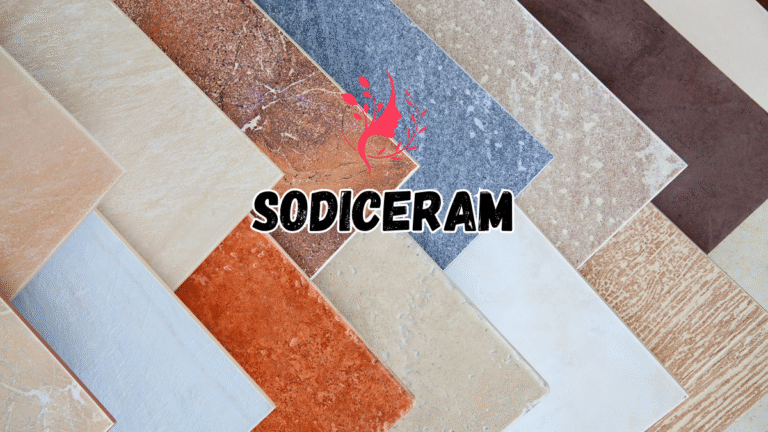Introduction to Sodiceram
In the world of advanced materials, sodiceram has emerged as a transformative force redefining how ceramics are perceived and applied. Unlike traditional ceramics, which have long been associated with fragility and decorative use, sodiceram offers an impressive combination of durability, thermal resistance, and versatility. This article delves deep into what makes sodiceram unique, its wide-ranging applications, and why it’s considered the next big thing in material science.
What Is Sodiceram?
Sodiceram is a term used to describe a new class of engineered ceramics that integrate sodium-based compounds with high-performance ceramic matrices. This innovation allows sodiceram to achieve properties unattainable by conventional ceramics, including:
- Extreme thermal stability
- Superior mechanical strength
- Chemical resistance in aggressive environments
- Lightweight yet dense microstructure
By enhancing traditional ceramic materials with advanced engineering techniques, sodiceram is bridging the gap between metal alloys and polymers in industries that demand resilience and precision.
The Science Behind Sodiceram
The unique properties of sodiceram stem from its microstructural engineering. Using precision sintering and molecular alignment technologies, sodiceram manufacturers have been able to:
- Minimize porosity for improved strength
- Embed sodium ions for enhanced conductivity
- Create grain boundaries that resist crack propagation
This combination makes sodiceram particularly suitable for applications where high stress and thermal shock resistance are non-negotiable.
Key Advantages of Sodiceram Over Traditional Ceramics
Unlike its predecessors, sodiceram offers benefits that redefine its usability:
- Unmatched Thermal Resistance
Sodiceram can withstand temperatures exceeding 1,400°C without degradation, making it ideal for aerospace and energy applications. - Enhanced Mechanical Strength
The reinforced crystalline structure prevents fractures even under high stress, enabling its use in load-bearing components. - Chemical and Corrosion Resistance
Its inert nature makes sodiceram an excellent choice for chemical reactors and medical devices. - Lightweight Design
Compared to metals, sodiceram’s lightweight nature improves fuel efficiency in transport and reduces wear on moving parts.
Applications of Sodiceram Across Industries

Aerospace and Defense
Sodiceram’s high thermal tolerance makes it indispensable for thermal shields, turbine blades, and ballistic armor.
Energy Sector
In the energy sector, sodiceram is used in fuel cells, heat exchangers, and nuclear reactors due to its ability to withstand extreme temperatures and corrosive environments.
Electronics
With sodium-enhanced conductivity, sodiceram plays a critical role in semiconductors, insulators, and battery technology.
Medical Technology
In the medical field, its biocompatibility has made sodiceram a material of choice for dental implants, surgical tools, and prosthetics.
How Sodiceram is Manufactured
The production of sodiceram involves several advanced processes:
- Raw Material Synthesis
Sodium compounds are combined with zirconia, alumina, or silicon carbide to achieve desired properties. - High-Temperature Sintering
Controlled sintering creates dense, uniform materials free from weak points. - Surface Treatments
Specialized coatings further enhance corrosion resistance and longevity.
Each step is carefully monitored to ensure sodiceram meets the strict demands of aerospace, medical, and industrial clients.
Environmental Impact and Sustainability
One of sodiceram’s hidden advantages is its contribution to sustainability:
- Longer Lifespan reduces waste
- Lightweight components lower fuel consumption in transportation
- Recyclable at end-of-life through advanced ceramic recycling programs
As industries pivot toward green technologies, sodiceram is positioned as a material that aligns with environmental goals.
Challenges and Future Developments
While sodiceram has shown immense promise, certain challenges remain:
- Cost of Production: Advanced ceramics require expensive raw materials and manufacturing setups.
- Scaling Up: Producing large quantities without compromising quality is still a technical hurdle.
- Standardization: Industry-wide standards for sodiceram applications are in their infancy.
However, ongoing research and development are addressing these issues. In the coming decade, we can expect:
- Cost-effective production techniques
- New composites combining sodiceram with nanomaterials
- Broader adoption in consumer products
Why Sodiceram Is a Game Changer
What sets sodiceram apart from other high-tech materials is its ability to deliver strength, resilience, and adaptability simultaneously. It isn’t just an alternative—it’s an enabler for technologies that previously seemed impossible.
From hypersonic vehicles to next-generation medical implants, sodiceram is proving its worth as a cornerstone material for the future.
Conclusion: The Rise of Sodiceram
Sodiceram isn’t just a scientific curiosity; it’s a revolution in material science. Its unique properties position it at the forefront of industries demanding high performance under extreme conditions. As manufacturing techniques evolve and costs decrease, sodiceram will likely find its way into everyday applications, transforming the way we build, heal, and explore.
For businesses and innovators, embracing sodiceram today means gaining a critical edge in tomorrow’s competitive landscape.
FAQ: Frequently Asked Questions About Sodiceram
What makes sodiceram different from traditional ceramics?
Sodiceram’s sodium-enhanced matrix gives it superior strength, thermal resistance, and chemical stability.
Can sodiceram be recycled?
Yes. Advanced recycling methods allow sodiceram components to be repurposed without significant loss of performance.
Where is sodiceram currently used?
It’s already in aerospace, energy, medical devices, and high-performance electronics.
For more information visite the website

